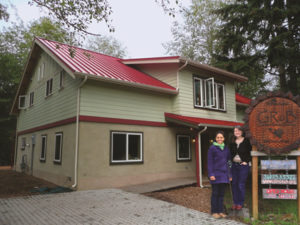Permeable ICF wall system at GRuB Education Center
Case Study: Published | Updated: | | Olympia, Washington | 66800005200
Olympia, WA, USA
- Category
- category_listing(s)
- Building Type
- Other
- Innovation
- Faswall ICF
- Jurisdiction
- Olympia, Washington
- Parcel
- 66800005200
- Officials
- Tom Hill | City of Olympia
- Team
-
Kim Gaffi
|
owner
Blu Peetz | owner
Barrett Burr | builder
Elizabeth Diane | Designer
Joseph Becker | subcontractor
Addison Bowe | contributor
- Ratings & Awards
-
Level 5 Built Green

Garden Raised Bounty is a non-profit environmental learning center built upon the generosity of a whole community. The first-floor walls were constructed with Faswall ICF’s (insulated concrete forms), creating an efficient open-diffusion permeable wall system. Non prescriptive parts to this project include custom engineering for an ICF, energy code compliance an non prescriptive wall assembly.
The Builders and Designers worked closely with the City of Olympia to ensure code compliance. The permitting process wasn’t challenging in this specific instance but could have been if the code official weren’t familiar with the product.
| Code Requirement | Compliance Path |
|---|---|
| Structural: IRC 611 Exterior Concrete Wall Construction | Custom Engineering by Harriet Engineers |
| Energy Code | Effective R value of Faswall ICF as provided by Faswall |
| Vapor Retarder: R 601.3 Vapor Retarders | Vapor Permeable wall system study including Durisol (equivalent to Faswall) |
| Code Requirement | Compliance Path |
|---|---|
| Structural: IRC 611 Exterior Concrete Wall Construction | Custom Engineering by Harriet Engineers |
| Energy Code | Effective R value of Faswall ICF as provided by Faswall |
| Vapor Retarder: R 601.3 Vapor Retarders | Vapor Permeable wall system study including Durisol (equivalent to Faswall) |